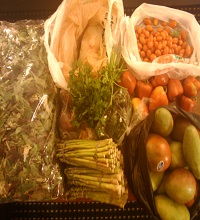Fresh Homemade Mozzarella Cheese
April 5th, 2020
Prep Time: 01 hour 30 minutes
Cook Time: 0:00
Fresh Mozzarella Cheese is surprisingly easy to make, once you learn a few tricks. In less than an hour, you can go from a Gallon of Whole Milk to Mozzarella. And as an added bonus, Ricotta Cheese is also a natural byproduct of the Mozzarella making process.
Ingredients:
==========
1 Gallon Whole Milk
Animal Rennet
1.5 Teaspoons Citric Acid
Salt (use Table Salt, Kosher Salt, or Sea Salt)
Less than 1/4 cup of chlorine-free drinking water in a small container
Less than 1/4 cup of chlorine-free drinking water in a different small container
The Milk:
The Milk matters. Do not use milk that is past (or nearing) the expiration date. You will want to have full control over the bacteria present, with no naturally occurring cultures. You can use Pasteurized milk, but do not use Ultra High Temperature (UHT) Pasteurized milk.
I have never attempted to make any cheese using raw milk, but I know that it can be done. As a reminder, always ensure that you use safe practices and that you sanitize all of your tools and your work space before you begin.
I do not have a lot of experience using National Milk brands to make cheese. Surprisingly, it seems that the price of the milk has no bearing on the value for making cheese.
Locally, I know that the Central Market brand will not produce a good curd.
Alternatively, Hill Country Fare brand will generally produce an excellent curd, although Hill Country Fare is considerably cheaper than the Central Market brand.
Tablet or Liquid Rennet
Junket brand Rennet can be found in most grocery stores. Junket Rennet comes in a tablet and should be stored in a cool dry place, or in the refrigerator for best results. Junket Rennet, if stored properly, should be good for 18 months to 2 years.
Liquid Rennet can be found in 1x and 2x concentrations and will usually need to be purchased online. Liquid Rennet should be stored in the refrigerator. Liquid Rennet, if stored properly, should be good for about 6 months.
Use about 1/4 to 1/2 tablet Junket brand Rennet per 1 gallon of milk
OR
About 1/4 to 1/2 Teaspoon 1x Liquid Animal Rennet per 1 gallon of milk
The Salt:
Salt is a necessary part of making any cheese as it helps bring out the flavor of the cheese. Without ANY sodium, a cheese will have a bitter flavor that makes it inedible. You can use Table Salt, Sea Salt, or Kosher Salt, preferably with a fine grind.
Tools:
Large non-reactive cooking pot with a lid (I prefer to use an enamel-lined cast iron pot, since it maintains temperature well)
Another large pot
Instant-read Thermometer
Large plastic Colander or Large Mesh Sieve
Clean Tea Towel
2 small glasses or small bowls, able to hold 1/4 Cup each
Long Knife
Large Plastic Slotted Spoon
Large Glass or Large Plastic Bowl
Medium-sized glass bowl
Ice for the medium-sized bowl
Cold Water for the medium-sized bowl
Thermally insulated food-safe Rubber Gloves
Directions:
=========
Making Mozzarella Cheese is not difficult, but there are many details that you must be exactly right. You should read and understand every step in these instructions before attempting to make Mozzarella Cheese.
Preparation
Sanitize all your tools and work space.
Dissolve the Citric Acid into 1 or 2 ounces of drinking water in one of the small glass bowls.
Dissolve the Rennet in 1 or 2 ounces drinking water, in the other small glass bowl.
Instructions
1. Heat the Milk
In a large non-reactive pot, mix the milk with the Citric Acid and then heat to exactly 90° Fahrenheit.
2. Add the Rennet
Remove from heat and mix in the Rennet, stirring well. Cover the pot and let it rest for about 5 minutes.
3. Wait for a "Clean" Break
Remove the lid and use your finger to check the curd for a "clean" break. If it is not ready, cover and let it sit for another 5 minutes. continue to check about every 5 minutes or so.
When you can get a "clean" break, you are ready to move onto the next steps.
What is a Clean Break?
Using your finger, make a small trench in the surface of the curd. If the trench remains after you remove your finger, this called a "clean" break. If the curd collapses back into the trench right away, the curd is not yet ready.
NOTE: Do not continue until you can make a "clean" break in the curd.
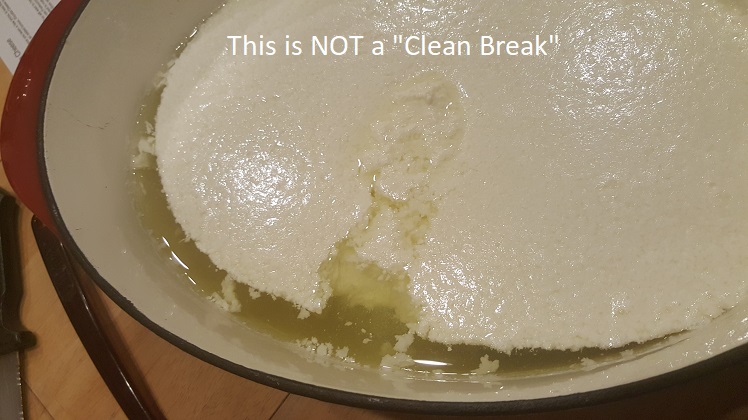
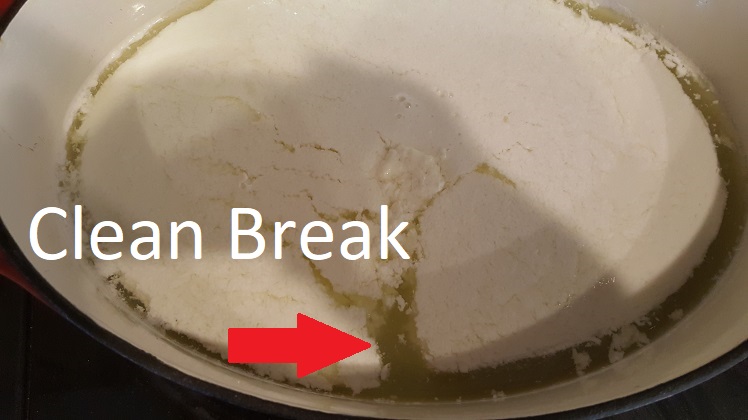
If you cannot get to the clean break stage after about an hour (checking every 5 minutes or so), it is likely that there was something wrong with your rennet or your Milk. Unfortunately, Mozzarella isn't going to happen from this batch. But have no fear, you can still use the mixture to produce a tasty batch of Ricotta. Pick up the Ricotta instructions on Step 3.
4. Cut the Curds
Use a knife to cut a series of horizontal rows across the curd. The rows should be about an inch apart and the cuts should reach to the bottom of the container.
Add lines the other direction to create a grid pattern across the top of the curd. Again, the cuts should reach the bottom of the container.
5. Reheat the Milk
Place the curd back on the stove and heat until the curds reach exactly 105° Fahrenheit.
6. Separate the Curds and the Whey
Remove the pot from the stove.
Take the Colander or the sieve.
Place the Colander or Sieve over the large glass bowl to catch the whey.
Use the plastic slotted spoon and move the curds into the Colander or Sieve.
Drain the whey (liquid) from the curds (solid).
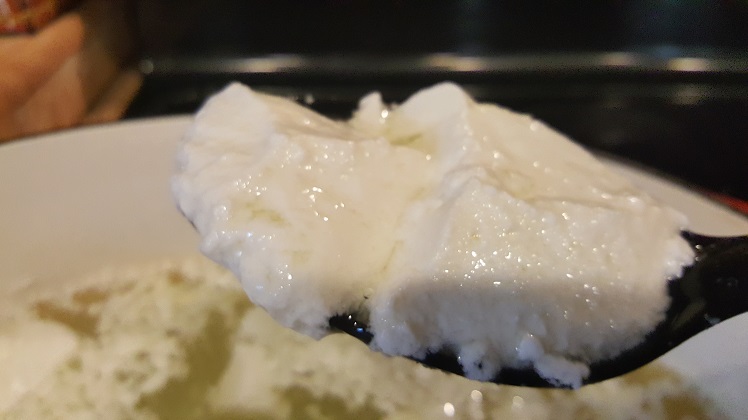
The curds should be solid enough that they are almost the consistency of soft tofu. If the curds break apart and flow through the slots in the spoon, you will be making Ricotta Cheese today, instead of Mozzarella Cheese.
Stir and press the curds with the spoon to help drain more whey.
Retain the whey as it drains into the bowl, this will be needed for the next step.
Work the curd into a ball. Continue to squeeze and work with the curds to drain out as much whey as possible.
7. Cook the Curds
Ready an ice bath by mixing water and ice in the medium-sized glass bowl. Set it aside.
Heat the Whey (or salted water) to 185° Fahrenheit. You should have extracted just over 1/2 a gallon of Whey by this point.

Add the Curd back into the hot water and reheat until the curd reaches an internal temperature of 135° Fahrenheit. You will know they reach the right temperature when the curds become stretchy.
Wear the rubber gloves and gently stretch the curd and then fold several times and reform the curd into a ball.
Repeat.
Add kosher or Sea salt to the Curd as you continue to work it, for about 20 seconds.
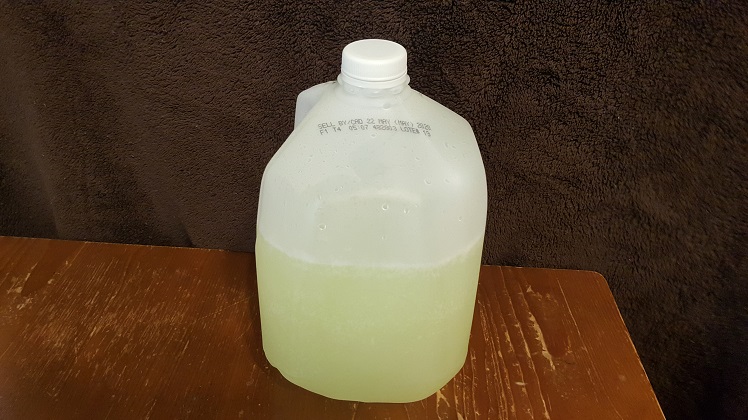
8. Form and Finish the Cheese
Form the curd into small balls
Immerse the Mozzarella ball(s) in the Ice Bath for 5 minutes to set the shape of the Mozzarella Curds.
Refrigerate in a sealed container with whey or salted water, for up to 2 weeks.
Bonus: Making Ricotta
Strictly speaking Ricotta is not a cheese, but a cheese byproduct.
Run the whey back through the coffee filters in the sieve/colander. Any remaining curds can be collected, drained, and salted.
This is Ricotta.
